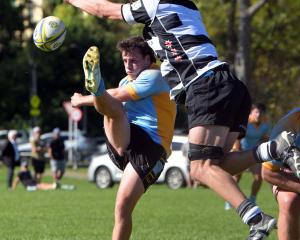ODT Online rugby writer Jeff Cheshire identifies five key points from the All Blacks' test win over England in Auckland last night.
England defensive line speed
The speed with which the English came up on defence was essentially what this game came down to.
They were up very quickly, particularly out wide. This meant the All Blacks were always under pressure, trying to make things happen in limited space. Very rarely did they manage to get the ball wide and when they did look to spread the ball, so often it was dropped or turned over as the English defence held resolute.
This forced the All Blacks into playing a kicking game to try to get the England outside backs to stand deeper, while getting the rest of the line to hold back a little in case they needed to cover. Unfortunately the home side's kicking game was not good enough - kicks were too long, allowing the English to force the ball over their own line.
Too many mistakes
The All Blacks' skill level was poor. Too often attacking movements were squandered by passes thrown too high or not to the man. Other times the ball was dropped. There is no excuse for these errors, even if they were under pressure a lot of the time. It is these movements that will determine how much you win a game by, or even if you win.
While the forwards work hard to put you into a position to win, you still need to take advantage of the chances when you do create an opening and the All Blacks did not do this. Consequently they scored just one try and rarely looked like scoring another one.
Back three
The back three of Israel Dagg, Beauden Barrett and Ben Smith had limited opportunities, but even so they were not flash. Their high ball reception was not great, with all looking vulnerable at times and consequently the English looked to the air frequently. The got up fast and cut down the space, but it was the All Blacks' inability to catch the ball that prevented any real counter-attacking movements being launched.
The two wingers should also swap sides to get maximum value out of the two as a combination. Cory Jane was largely wasted on the left wing, given his biggest attacking weapon is his strong left-handed fend. By playing him on the left wing, he was on the wrong side of the field to make use of this as any defensive threats were on his right-hand side.
A shift to the left wing would be less of a disruption to Ben Smith, as he is primarily a fullback. He is not so much a strong fender either, more one to see holes and step through tackles, which should not be affected by switching wings.
In general you expect the right winger to have to field more high balls, as this is the easier side to kick to for right-footed kickers. As Jane is the best of these three under the high ball, he would be the logical choice to fill the No. 14 jersey, while using Smith on the other wing. That said, when Julian Savea comes back he will be the left winger and Jane and Smith will be left to fight for the one spot.
Strong second half
If you say the first half was fairly even, you would have to say the All Blacks had the upper-hand in the second. They dominated the territory stakes for large periods and had the English under pressure. England's defence was brilliant, holding out an All Black side that was building pressure.
Uultimately the All Blacks were their own worst enemies, unable to cash in on this dominance by dropping too much ball and failing to execute.
Lack of direction
The decision to start Aaron Cruden surprised a few people this week and he indeed looked a bit out of sorts. This is not to say that he is not a good player who would start under normal circumstances. But given he has seen so little rugby this year and Beauden Barrett has been in such great form, it may have been a better option to use Barrett in the No. 10 jersey.
With the game tight and chances few, the All Blacks needed someone to steer them around the field and take control of the game. Cruden did not do this, mainly looking to distribute straight away and kicking long but struggling to put England under real pressure with his boot. He is so dangerous when he is taking the line on and looking to get players running off him and put them into space.
It seemed as though bringing Barrett into first five-eighth may have been a better option than replacing Dagg. At fullback Barrett did not convince and would have been far better off in the position where he has impressed so much over the past three seasons.













